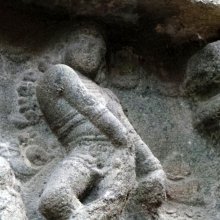Parivahita, Parivāhita: 7 definitions
Introduction:
Parivahita means something in Hinduism, Sanskrit. If you want to know the exact meaning, history, etymology or English translation of this term then check out the descriptions on this page. Add your comment or reference to a book if you want to contribute to this summary article.
Images (photo gallery)
In Hinduism
Natyashastra (theatrics and dramaturgy)
Source: Wisdom Library: Nāṭya-śāstraParivāhita (परिवाहित) refers to one of the thirteen gestures of the Head, which represents one of the six major limbs (aṅga) used to perform certain gestures (āṅgika), according to the Nāṭyaśāstra chapter 8.—Instructions: when the head is alternately turned to two sides it is called the Parivāhita. (Uses): The Parivāhita head is applicable in demonstration, surprise, joy, remembering, intolerence, cogitation, concealment and [amorous] sporting. (See the Nāṭyaśāstra 8-23)
Source: archive.org: The mirror of gesture (abhinaya-darpana)1) One of the Nine Movements of the Head. Parivāhita (wagging): the head is moved from side to side like a fan. Usage: being in love, yearning for the beloved, pleasure, gratification, reflection (vicāra).
2) One of the Twenty-four Heads. Parivāhita: turning the head in a circle. Usage: shamelessness, misapprehension, keeping silence, recalhng (the appearance etc. of) the beloved, astonishment, smiling, joy, horripilation, giving pleasure, reflection.
Source: Shodhganga: Elements of Art and Architecture in the Trtiyakhanda of the Visnudharmottarapurana (natya)Parivāhita (परिवाहित) refers to one of the seven movements of the head” (in Sanskrit Dramas), as conveyed through Āṅgikābhinaya: one of the four divisions of Abhinaya or “ways to convey or represent one’s emotion to others”, according to the Viṣṇudharmottarapurāṇa, an ancient Sanskrit text which (being encyclopedic in nature) deals with a variety of cultural topics such as arts, architecture, music, grammar and astronomy.—The āṅgikābhinaya includes the histrionic representation of the limbs which is simply known as physical gestures. In the Viṣṇudharmottarapurāṇa, seven types of movements of the head are recorded. The Parivāhita type of movement shows achievement, joy and sportiveness.

Natyashastra (नाट्यशास्त्र, nāṭyaśāstra) refers to both the ancient Indian tradition (shastra) of performing arts, (natya—theatrics, drama, dance, music), as well as the name of a Sanskrit work dealing with these subjects. It also teaches the rules for composing Dramatic plays (nataka), construction and performance of Theater, and Poetic works (kavya).
Languages of India and abroad
Sanskrit dictionary
Source: Cologne Digital Sanskrit Dictionaries: Shabda-Sagara Sanskrit-English DictionaryParivāhita (परिवाहित).—mfn.
(-taḥ-tā-taṃ) Drained. E. parivāha, and itac aff.
Source: Cologne Digital Sanskrit Dictionaries: Monier-Williams Sanskrit-English DictionaryParivāhita (परिवाहित):—[=pari-vāhita] [from pari-vah] mfn. drained, [Horace H. Wilson]
Source: Cologne Digital Sanskrit Dictionaries: Yates Sanskrit-English DictionaryParivāhita (परिवाहित):—[pari-vāhita] (taḥ-tā-taṃ) p. Drained.
Sanskrit, also spelled संस्कृतम् (saṃskṛtam), is an ancient language of India commonly seen as the grandmother of the Indo-European language family (even English!). Closely allied with Prakrit and Pali, Sanskrit is more exhaustive in both grammar and terms and has the most extensive collection of literature in the world, greatly surpassing its sister-languages Greek and Latin.
Kannada-English dictionary
Source: Alar: Kannada-English corpusParivāhita (ಪರಿವಾಹಿತ):—[noun] (dance.) a moving or turning of the head in a circular manner.
Kannada is a Dravidian language (as opposed to the Indo-European language family) mainly spoken in the southwestern region of India.
See also (Relevant definitions)
Partial matches: Vahita, Pari.
Full-text: Nine Heads, Twenty-four Heads, Achievement, Sportiveness, Nagapasarpita, Sarpita, Madaskhalita, Joy, Shiras, Chest, Head.
Relevant text
Search found 5 books and stories containing Parivahita, Parivāhita, Pari-vahita, Pari-vāhita; (plurals include: Parivahitas, Parivāhitas, vahitas, vāhitas). You can also click to the full overview containing English textual excerpts. Below are direct links for the most relevant articles:
Vishnudharmottara Purana (Art and Architecture) (by Bhagyashree Sarma)
1.3. Elements of Drama (c): Bodily Movements < [Chapter 3 - Drama and Dance]
Abhinaya-darpana (English) (by Ananda Coomaraswamy)
The Agni Purana (by N. Gangadharan)
Gati in Theory and Practice (by Dr. Sujatha Mohan)
Gati in Maṇipurī < [Chapter 4 - Practice of Gati]
Gati pertaining to conditions and situations < [Chapter 3 - Application of gati in Dṛśya-kāvyas]
Gaits pertaining to conditions < [Chapter 2 - Concept and technique of Gati]
Natyashastra (English) (by Bharata-muni)
